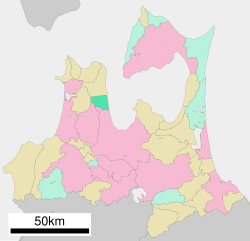Yomogita, Aomori
|
Yomogita 蓬田村 |
|||
|---|---|---|---|
| Village | |||

Yomogita Station
|
|||
|
|||
 Location of Yomogita in Aomori Prefecture |
|||
| Coordinates: 40°58′N 140°30′E / 40.967°N 140.500°ECoordinates: 40°58′N 140°30′E / 40.967°N 140.500°E | |||
| Country | Japan | ||
| Region | Tōhoku | ||
| Prefecture | Aomori | ||
| District | Higashitsugaru | ||
| Area | |||
| • Total | 80.65 km2 (31.14 sq mi) | ||
| Population (February 2015) | |||
| • Total | 3,042 | ||
| • Density | 37.7/km2 (98/sq mi) | ||
| Time zone | Japan Standard Time (UTC+9) | ||
| City symbols | |||
| • Tree | Japanese black pine | ||
| • Flower | Rosa rugosa | ||
| • Bird | Whooper swan | ||
| Phone number | 0174-27-2111 | ||
| Address | 1-3 Shiooshi, Yomogita-mura, Higashitsugaru-gun, Aomori-ken 030-1211 |
||
| Website | Official website | ||
Yomogita (蓬田村? Yomogita-mura) is a village located in Higashitsugaru District of northeastern Aomori Prefecture in the Tōhoku region of Japan. As of February 2015, the village had an estimated population of 3,042 and a population density of 37.7 persons per km2. Its total area was 80.65 km2.
Yomogita occupies the eastern coastline of Tsugaru Peninsula, facing Mutsu Bay. The village has a cold maritime climate characterized by cool short summers and long cold winters with heavy snowfall.
The area around Yomogita was controlled by the Nambu clan of Morioka Domain during the Edo period. During the cadastral reform of 1889, it was established as a village.
The economy of Yomogita is heavily dependent on agriculture (rice and tomatoes) and commercial fishing. Some of the locally caught seafood include sea urchin roe, sea cucumber, scallops, abalone and squid.
Yomogita has one elementary school and one middle school.
...
Wikipedia



